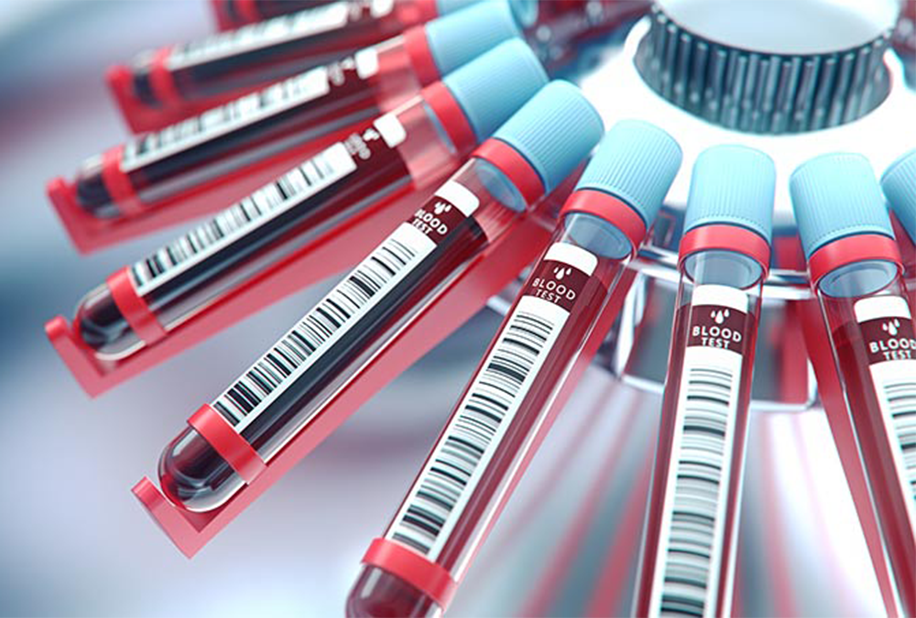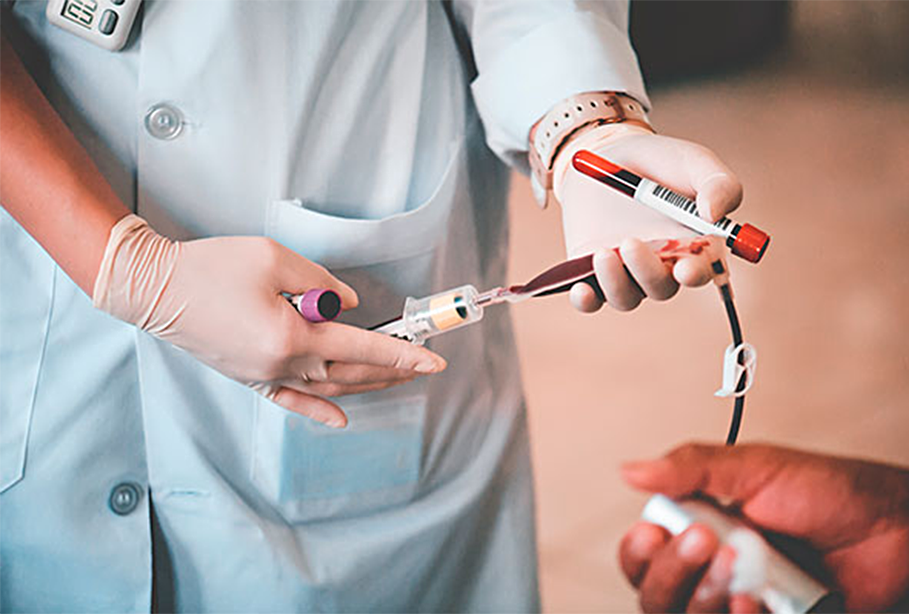Blood Disorders
Extensive experience with the broad array of blood disorders
Blood disorders (also called hematologic disorders) affect blood cells or proteins in the blood clotting or immune systems. Some common blood disorders include leukopenia (low white blood cell count) and pancytopenia (a decrease in red blood cells, white blood cells, and platelets).
Laboratory tests to detect blood disorders generally begin with an examination of the blood, which is easily obtained from a vein with a needle and syringe or sometimes from the fingertip by a needle prick. However, evaluation may require examination of the bone marrow, because that is where blood cells develop.

Laboratory blood tests
Doctors depend on many different laboratory tests of blood samples to diagnose and monitor diseases. Because the liquid portion of the blood (plasma) carries so many substances essential to the body’s functioning, blood tests tell us what is happening in many parts of the body.
It’s easier to test blood than obtain a tissue sample from a specific organ. For example, it’s easier to evaluate thyroid function by measuring the level of thyroid hormones in the blood than by taking a tissue sample from the thyroid. However, certain blood tests are used to measure blood components (red blood cells, white blood cells, and platelets) and blood function. These tests are used most often to diagnose blood disorders.
Complete blood count (CBC)
The most commonly performed blood test is the complete blood count (CBC), which evaluates all the cellular components. Automated machines perform this test in less than one minute on a small drop of blood. Sometimes, the CBC is supplemented by examining blood cells under a microscope.
The CBC determines the number of red blood cells and the amount of hemoglobin (the oxygen-carrying protein in red blood cells) in the blood. In addition, the average size, variability of size, and hemoglobin content of red blood cells are assessed by a CBC and alerts laboratory workers to the presence of abnormal red blood cells (which may then be further analyzed by microscopic examination).
Abnormal red blood cells may be fragmented or shaped like teardrops, crescents, needles, or a variety of other forms. Knowing the specific shape and size of red blood cells helps a doctor diagnose a particular cause of anemia. For example, sickle-shaped cells indicate sickle cell disease, small cells containing insufficient amounts of hemoglobin are likely due to iron deficiency anemia, and large oval cells suggest anemia due to a deficiency of folic acid or vitamin B12.
The CBC also determines the number of white blood cells. The specific types of white blood cells can be counted (differential white blood cell count) when a doctor needs more information. If the total number of white blood cells or the number of specific types of white blood cells is above or below normal, the doctor can examine these cells under a microscope. The microscopic examination can identify features that are typical of certain diseases. For example, large numbers of white blood cells that have a very immature appearance (blasts) may indicate leukemia (cancer of the white blood cells).
Platelets are usually also counted as part of a CBC. The number of platelets is an important measure of the blood’s ability to stop bleeding (clotting). A high number of platelets (thrombocytosis or thrombocythemia) can lead to blood clots in small blood vessels, especially those in the heart or brain. In some disorders, a high number of platelets may even result in excess bleeding.
Reticulocyte count
The reticulocyte count measures the number of newly formed red blood cells (reticulocytes) in a specified volume of blood. Reticulocytes normally make up about 1% of the total number of red blood cells. When the body needs more red blood cells, as in anemia, the bone marrow normally produces more reticulocytes. So the reticulocyte count measures the capacity of bone marrow to make new red blood cells.
Special tests of blood cells
Once a doctor determines that something is wrong with cell types in the blood, many additional tests are available to shed light on the problem. Doctors can measure the proportion of the different types of white blood cells and can determine subtypes of these cells by assessing certain markers on the surface of the cells. Tests are available to:
- Measure the ability of white blood cells to fight infection
- Assess the functioning of platelets and their ability to clot
- Measure the content of red blood cells to help determine the cause of anemia or why the cells are not functioning properly
Most of these tests are done on samples of blood, but some require a bone marrow sample.
Other blood tests
Specialized blood tests help determine whether uncommon blood disorders are present. For example, on rare occasions, doctors must measure the total volume of blood or the total number of certain blood cells in the body. These measurements use radioactive isotopes that mix in the blood or attach to blood cells.
Blood typing
Measuring the reaction of a small sample of a person’s blood to certain antibodies determines blood type (the presence of certain proteins on the surface of red blood cells). Blood typing requires evaluation of both the plasma and red blood cells and must be done before blood can be transfused.

Proteins and other substances
Some blood cells produce proteins that can be measured in the blood or urine to determine if the cells are abnormal. For example, a blood disorder in which certain red blood cells, called plasma cells, become cancerous produces unusual proteins (Bence-Jones proteins). Certain abnormal white blood cells produce unusual antibodies.
Erythropoietin is a protein made in the kidneys that stimulates the bone marrow to produce red blood cells. Measuring blood levels of this protein and several others help determine the effect of red blood cell production. Also valuable: measuring levels of iron and certain vitamins needed for the production of healthy blood cells.
Clotting tests
One measure of the body’s ability to stop bleeding is its number of platelets. Sometimes doctors need to test how well the platelets function. Other tests can measure the overall function of the many proteins needed for normal blood clotting (clotting factors) or the level of individual clotting factors. The most common of these tests are the prothrombin time (PT) and the partial thromboplastin time (PTT).
Ready to get started with treatment?
We are one of the largest oncology community practices in the United States. With 60+ practices in California, Arizona, Nevada, and Florida, we are an integral part in each community we serve.
The Oncology Institute of Hope and Innovation offers state-of-the-art treatment for all these blood disorders
- Acute lymphoblastic leukemia
- Acute myeloid leukemia
- Anemia
- Antiphospholipid syndrome
- Aplastic anemia
- Deep vein thrombosis
- Essential or primary thrombocythemia
- Fanconi anemia
- Hemochromatosis
- Hemolytic anemia
- Hodgkin's lymphoma
- Idiopathic myelofibrosis
- Iron-deficiency anemia
- Leukopenia
- Myelodysplasia
- Neutropenia
- Non-Hodgkin's lymphoma
- Pancytopenia
- Pernicious anemia
- Polycythemia vera
- Sickle cell anemia
- Thalassemias
- Thrombocythemia and thrombocytosis
- Thrombocytopenia
- Thrombotic thrombocytopenic purpura (TTP)
- Waldenström macroglobulinemia
- Acute lymphoblastic leukemia
- Acute myeloid leukemia
- Anemia
- Antiphospholipid syndrome
- Aplastic anemia
- Deep vein thrombosis
- Essential or primary thrombocythemia
- Fanconi anemia
- Hemochromatosis
- Hemolytic anemia
- Hodgkin's lymphoma
- Idiopathic myelofibrosis
- Iron-deficiency anemia
- Leukopenia
- Myelodysplasia
- Neutropenia
- Non-Hodgkin's lymphoma
- Pernicious anemia
- Pancytopenia
- Polycythemia vera
- Sickle cell anemia
- Thalassemias
- Thrombocythemia and thrombocytosis
- Thrombocytopenia
- Thrombotic thrombocytopenic purpura (TTP)
- Waldenström macroglobulinemia

